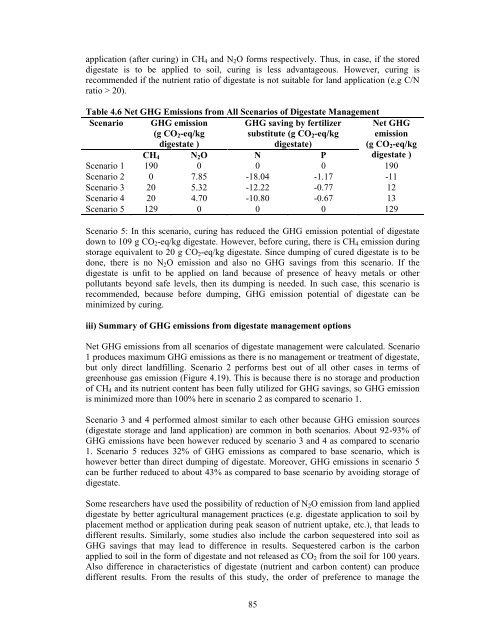dry anaerobic digestion of municipal solid waste and digestate ...
dry anaerobic digestion of municipal solid waste and digestate ...
dry anaerobic digestion of municipal solid waste and digestate ...
You also want an ePaper? Increase the reach of your titles
YUMPU automatically turns print PDFs into web optimized ePapers that Google loves.
application (after curing) in CH 4 <strong>and</strong> N2O forms respectively. Thus, in case, if the stored<br />
<strong>digestate</strong> is to be applied to soil, curing is less advantageous. However, curing is<br />
recommended if the nutrient ratio <strong>of</strong> <strong>digestate</strong> is not suitable for l<strong>and</strong> application (e.g C/N<br />
ratio > 20).<br />
Table 4.6 Net GHG Emissions from All Scenarios <strong>of</strong> Digestate Management<br />
Scenario GHG emission<br />
(g CO2-eq/kg<br />
<strong>digestate</strong> )<br />
GHG saving by fertilizer<br />
substitute (g CO2-eq/kg<br />
<strong>digestate</strong>)<br />
CH4 N2O N P<br />
85<br />
Net GHG<br />
emission<br />
(g CO2-eq/kg<br />
<strong>digestate</strong> )<br />
Scenario 1 190 0 0 0 190<br />
Scenario 2 0 7.85 -18.04 -1.17 -11<br />
Scenario 3 20 5.32 -12.22 -0.77 12<br />
Scenario 4 20 4.70 -10.80 -0.67 13<br />
Scenario 5 129 0 0 0 129<br />
Scenario 5: In this scenario, curing has reduced the GHG emission potential <strong>of</strong> <strong>digestate</strong><br />
down to 109 g CO2-eq/kg <strong>digestate</strong>. However, before curing, there is CH4 emission during<br />
storage equivalent to 20 g CO2-eq/kg <strong>digestate</strong>. Since dumping <strong>of</strong> cured <strong>digestate</strong> is to be<br />
done, there is no N2O emission <strong>and</strong> also no GHG savings from this scenario. If the<br />
<strong>digestate</strong> is unfit to be applied on l<strong>and</strong> because <strong>of</strong> presence <strong>of</strong> heavy metals or other<br />
pollutants beyond safe levels, then its dumping is needed. In such case, this scenario is<br />
recommended, because before dumping, GHG emission potential <strong>of</strong> <strong>digestate</strong> can be<br />
minimized by curing.<br />
iii) Summary <strong>of</strong> GHG emissions from <strong>digestate</strong> management options<br />
Net GHG emissions from all scenarios <strong>of</strong> <strong>digestate</strong> management were calculated. Scenario<br />
1 produces maximum GHG emissions as there is no management or treatment <strong>of</strong> <strong>digestate</strong>,<br />
but only direct l<strong>and</strong>filling. Scenario 2 performs best out <strong>of</strong> all other cases in terms <strong>of</strong><br />
greenhouse gas emission (Figure 4.19). This is because there is no storage <strong>and</strong> production<br />
<strong>of</strong> CH4 <strong>and</strong> its nutrient content has been fully utilized for GHG savings, so GHG emission<br />
is minimized more than 100% here in scenario 2 as compared to scenario 1.<br />
Scenario 3 <strong>and</strong> 4 performed almost similar to each other because GHG emission sources<br />
(<strong>digestate</strong> storage <strong>and</strong> l<strong>and</strong> application) are common in both scenarios. About 92-93% <strong>of</strong><br />
GHG emissions have been however reduced by scenario 3 <strong>and</strong> 4 as compared to scenario<br />
1. Scenario 5 reduces 32% <strong>of</strong> GHG emissions as compared to base scenario, which is<br />
however better than direct dumping <strong>of</strong> <strong>digestate</strong>. Moreover, GHG emissions in scenario 5<br />
can be further reduced to about 43% as compared to base scenario by avoiding storage <strong>of</strong><br />
<strong>digestate</strong>.<br />
Some researchers have used the possibility <strong>of</strong> reduction <strong>of</strong> N2O emission from l<strong>and</strong> applied<br />
<strong>digestate</strong> by better agricultural management practices (e.g. <strong>digestate</strong> application to soil by<br />
placement method or application during peak season <strong>of</strong> nutrient uptake, etc.), that leads to<br />
different results. Similarly, some studies also include the carbon sequestered into soil as<br />
GHG savings that may lead to difference in results. Sequestered carbon is the carbon<br />
applied to soil in the form <strong>of</strong> <strong>digestate</strong> <strong>and</strong> not released as CO2 from the soil for 100 years.<br />
Also difference in characteristics <strong>of</strong> <strong>digestate</strong> (nutrient <strong>and</strong> carbon content) can produce<br />
different results. From the results <strong>of</strong> this study, the order <strong>of</strong> preference to manage the

















